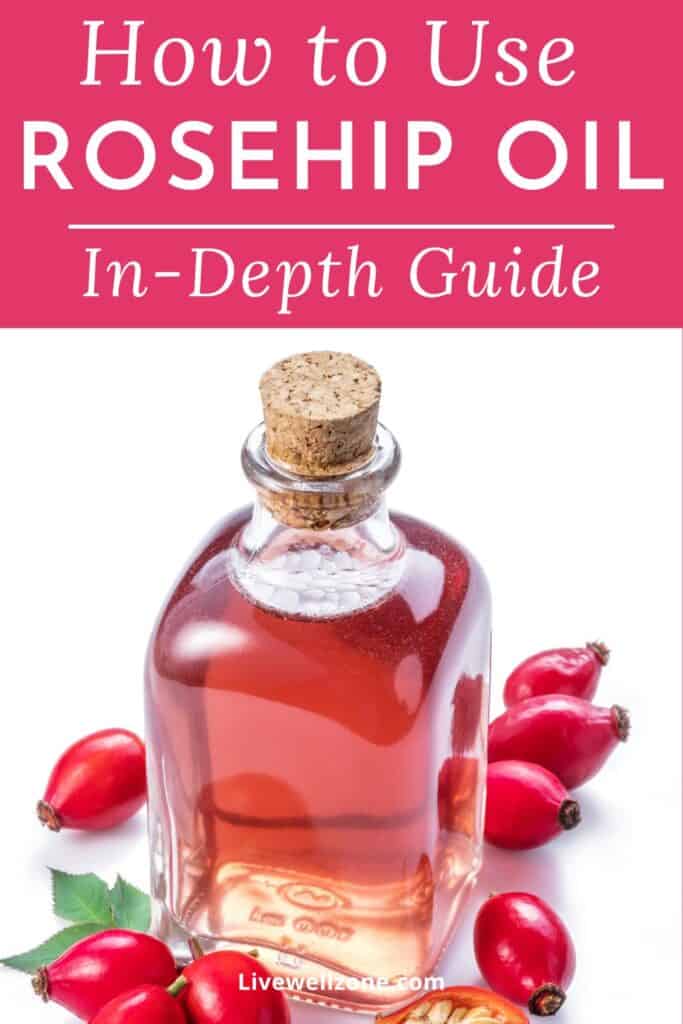
So you’ve got your bottle of rosehip oil and you’re wondering how often to use it, when to use it and basically, how it fits into your beauty regimen.
Well, you’re in the right place because this article covers everything you need to know about how to add rosehip oil to your skin care routine.
From how often to use it, to how to layer it with moisturizer, this quick guide has got you covered. So let’s get right to it!
HOW TO USE ROSEHIP SEED OIL

1. Use Daily (Morning or Night)
Rosehip oil can be used daily and ideally, either in the morning or at night.
If your skin is naturally very dry or you experience occasional dryness, then using it during the day can help to protect your skin as you go about your day.
On the other hand, applying it at night is a good way of enjoying its regenerative properties, especially because the skin does most of its repair work while we’re sleeping!
2. Apply Rosehip Oil Before Moisturizer
Since rosehip oil is an occlusive, it creates a barrier on the skin. Therefore it is best to apply it after your moisturizer (and other water-based products). This ensures that your skin actually absorbs the moisturizer, while the rosehip oil locks in the moisture.
Also, keep in mind that there are different sources of moisture – other than a moisturizer – that you can apply to the skin.
For example, you can mist your face with a hydrosol like rosewater or chamomile water. Then you can apply rosehip oil.
Another option is to simply make sure that your face is damp with plain water before applying rosehip oil.
No matter which approach you take, the main goal is to make sure that your face already is prepped with some moisture first.
3. Mix With Moisturizer
If you don’t feel like layering moisturizer and rosehip oil, you can simply mix them together as follows:
- Place moisturizer in the palm of your hand (the amount that you would normally use for one application).
- Add in two drops of rosehip oil. Blend in the palm of your hand.
- Massage the mixture onto your face.
4. Follow Up With Sunscreen
Rosehip oil – and all oils – should be applied as the last step in your routine, just before sunscreen.
Once you apply the oil, be sure to wait a few minutes before you apply sunscreen.
5. Add To Your DIY Oil Cleanser
Rosehip oil is non-comedogenic, making it suitable for gently removing excess sebum and makeup from all skin types.
For oil cleansing purposes, you can combine rosehip oil with other nourishing oils like jojoba, sesame or safflower. For more on this topic and to find the right combination of oils for your skin, please read this guide on how to double cleanse.
6. Add to Clay Masks
Looking for a simple way to make your clay masks less drying? Just add a few drops of rosehip oil to the mix.
Not only will it leave your skin feeling less parched, but it also adds to the nourishment you get from the mask.
7. Make A Stretch Mark Oil
Thanks to its high beta-carotene content – which is converted to vitamin A – rosehip oil is often used as a remedy for stretch marks.
You can use it on its own for this purpose or you can combine it with jojoba, apricot and castor oils to make a more potent stretch mark blend (get the recipe here).
Rosehip oil – and all oils – should be applied as the last step in your routine, just before sunscreen.
Once you apply the oil, be sure to wait a few minutes before you apply sunscreen.
FAQs ABOUT ADDING ROSEHIP OIL TO YOUR SKINCARE ROUTINE
Can you apply rosehip oil directly to skin?
Rosehip oil should not be applied directly to dry skin. Rather, it should be applied to damp skin or skin that has already been moisturized. Doing this allows the oil to seal in moisture and also prevents your skin from feeling excessively greasy.
What can I mix with rosehip oil for my face?
You can combine rosehip oil with clays, essential oils, other carrier oils and much more. For a detailed look at how to use these ingredients with rosehip oil, be sure to read this guide on what to mix (and not) with rosehip oil.
What does rosehip oil do for skin?
Rosehip oil can be helpful for (1, 2, 3, 4):
- Reducing hyperpigmentation.
- Supporting collagen production.
- Reducing the appearance of wrinkles and fine lines.
- Improving the appearance of scars.
- Fighting off inflammation of the skin.
- Protecting the skin from free radical damage.
- Preventing and minimizing stretch marks.
CONCLUSION
Rosehip oil is a lightweight, easily absorbable and non-comedogenic oil that can be used daily in a variety of ways.
I hope that this article has answered all your questions about using this amazing oil. To learn more about rosehip, be sure to check out the resources listed below.
You Might Also Like:
The Difference Between Rosehip Oil and Rosehip Seed Oil: Benefits, Which To Use and How to Use
How To Choose The Best Rosehip Oil: 5 Things to Look For (and Recommended Brands)
Why You Need Rosehip Oil For Hyperpigmentation (& How To Use)
Grapeseed Oil vs Rosehip Oil for Skin: Benefits, Which Is Better and Uses
Rosehip Oil vs Hyaluronic Acid: Benefits, Differences & How To Use Them
Which is Better: Rosehip Oil or Retinol? A Complete Guide
Evening Primrose Oil vs Rosehip Oil: Benefits, Differences, How to Use & Best Brands
Rosehip Oil vs Jojoba Oil for Face (And Body): Which is Better and How To Use
Rosehip Oil for Skin: A Complete Guide
Vitamin C Serum vs Rosehip Oil: Benefits, Which Is Better and How To Use


